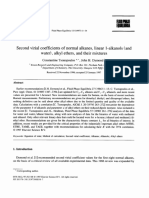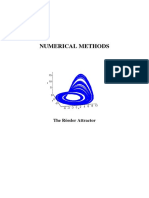Binary Conversion AND Logic Gates
Uploaded by
Ajit Pratap SinghBinary Conversion AND Logic Gates
Uploaded by
Ajit Pratap SinghBINARY CONVERSION AND LOGIC GATES
CONTENTS
DIGITAL NUMBER SYSTEM
DIGITAL NUMBER SYSTEM
DECIMAL BINARY OCTAL HEXADECIMAL
DECIMAL NUMBER SYSTEM
Composed of 10 numerals or symbols i.e 0-9. It is also called base 10 system. It is a positional value system because the value of a digit depends on its position.
POSITIONAL VALUES
103
2
102
5
101
1
100
2
10-1
1
10-2
9
10-3
7
10-4
1
MSB
DECIMAL POINT
LSB
BINARY NUMBER SYSTEM
Composed of 2 numerals or symbols i.e 0 and 1. It is also called base 2 system. It is a positional value system.
BINARY
POSITIONAL VALUES
2^3
2^2
2^1
2^0
2^-1
2^-2
2^-3
2^-4
MSB
BINAY POINT
LSB
OCTAL NUMBER SYSTEM
Composed of 8 numerals or symbols i.e 0 and 7. It is also called base 8 system. It is a positional value system.
POSITIONAL VALUES
83
2
82
5
81
1
80
2
8-1
1
8-2
9
8-3
7
8-4
1
MSB
OCTAL POINT
LSB
HEXADECIMAL NUMBER SYSTEM
Composed of 16 numerals or symbols i.e 0 9 and A to F.(A=10,F=15) It is also called base 16 system. It is a positional value system.
POSITIONAL VALUES
163
162
161
160
16-1
16-2
16-3
16-4
2
MSB
1
LSB
OCTAL POINT
Conversion Among Bases
The possibilities:
Decimal Octal
Binary
Hexadecimal
DECIMAL
BINARY
OCTAL
HEXADECIMAL
We use REPEATED -DIVISION METHOD for conversion. Number is successively divided by the base i.e 2 ,8 or 16 and its remainders recorded. Final binary result is obtained by assembling all the remainders from tail to head. Last remainder being the most significant bit (MSB)
DIVISION 95/ 2 47/ 2 23/ 2 11/2 5/2 2/2 1/2 ANSWER QUOTIENT 47 23 11 5 2 1 0 REMAINDER (BINARY) 1 1 1 1 1 0 1 1011111 DIVISION 256 / 16 16 / 16 1 / 16 ANSWER QUOTIENT 16 1 0 REMAINDER (in HEX) 0 0 1 100 DIVISION 25/ 8 3/ 8 ANSWER QUOTIENT 3 0 REMAINDER (in OCTAL) 1 3 31
CONVERTING DECIMAL FRACTION TO BASE 2 , 8 , 16
The procedure is to successively multiply the decimal fraction by the radix that is base and collect all the numbers to the left of the decimal point. The first reminder becomes the least significant digit(LSD) and the last reminder becomes the most significant digit(MSD).
Convert 0.375 in base 10 to binary Integer part 0 1 1
Multiply (fraction part) 0.375 by 2 Multiply (fraction part) 0.750 by 2 Multiply (fraction part) 0.50 by 2 Reading down the integer part,
0.750 1.50 1.00 0.375 = 0.011(base 2)
Convert 0.37510 to octal Multiply (fraction part) 0.375 by 8 0.37510 = 0.38 3.0 Integer part 3
Convert 0.0312510 to hexadecimal Multiply (fraction part) 0.03125 by 16 Multiply (fraction part) 0.5 by 16 0.0312510 = 0.0816 0.5 8.0 Integer part 0 8
CONVERSION TO DECIMAL FROM BASE 2 , 8 , 16
BINARY OCTAL HEXADECIMAL
DECIMAL
To convert from any base to decimal number, we multiply each digit by its weighted position, and add each of the weighted values together.
2^-1 2^4
2^-2
2^-3
What is 1010012 in decimal
You might also like
- Computer Organization - Data Representation On CPUNo ratings yetComputer Organization - Data Representation On CPU67 pages
- Evaluation, Control of Hazards and RisksNo ratings yetEvaluation, Control of Hazards and Risks30 pages
- Basic-Configuration-and-Installation-of-Operating-System FinalNo ratings yetBasic-Configuration-and-Installation-of-Operating-System Final43 pages
- COC1 - Installation of OS and Application SoftwareNo ratings yetCOC1 - Installation of OS and Application Software19 pages
- Module 4 Sheet 3.5 Installation of Peripherals Network Devices and Other IO DevicesNo ratings yetModule 4 Sheet 3.5 Installation of Peripherals Network Devices and Other IO Devices23 pages
- Cleaning Computer's Components and PeripheralsNo ratings yetCleaning Computer's Components and Peripherals27 pages
- Computer Networks: Understanding Computers: Today and Tomorrow, 13th EditionNo ratings yetComputer Networks: Understanding Computers: Today and Tomorrow, 13th Edition60 pages
- CHS Module 2 - Configuring Computer Systems and NetworksNo ratings yetCHS Module 2 - Configuring Computer Systems and Networks39 pages
- Identify and Resolve Network Problems LO 1No ratings yetIdentify and Resolve Network Problems LO 111 pages
- Von-Neumann Vs Harvard Architecture Differences & UsesNo ratings yetVon-Neumann Vs Harvard Architecture Differences & Uses12 pages
- Data Recovery and Collection of EvidenceNo ratings yetData Recovery and Collection of Evidence14 pages
- 2.3.3.3 Lab - Building A Simple Network - ILMNo ratings yet2.3.3.3 Lab - Building A Simple Network - ILM18 pages
- Simulab Activity 3.1: Ammeter, Voltmeter, and OhmmeterNo ratings yetSimulab Activity 3.1: Ammeter, Voltmeter, and Ohmmeter11 pages
- Chapter Three Number System and Data RepresentationNo ratings yetChapter Three Number System and Data Representation14 pages
- COM 221 Basic Computer Networks Lecture Note 2022No ratings yetCOM 221 Basic Computer Networks Lecture Note 2022118 pages
- Introduction To Computer Architecture and OrganizationNo ratings yetIntroduction To Computer Architecture and Organization40 pages
- C++ Programming II: Compiled by Mr. Abunu TNo ratings yetC++ Programming II: Compiled by Mr. Abunu T85 pages
- Networking in University Project Report National University of Computer and Emerging SciencesNo ratings yetNetworking in University Project Report National University of Computer and Emerging Sciences6 pages
- Clasification of Hazards and Risks and Its EffectsNo ratings yetClasification of Hazards and Risks and Its Effects19 pages
- Types of User Interface: Presented By: Rev. Chester Dave Allman JPNo ratings yetTypes of User Interface: Presented By: Rev. Chester Dave Allman JP19 pages
- Formal Methods in Software Engineering: Lecture # 01No ratings yetFormal Methods in Software Engineering: Lecture # 0164 pages
- IT 220: Computer Organization: Part I-C: Computer Hardware ComponentsNo ratings yetIT 220: Computer Organization: Part I-C: Computer Hardware Components10 pages
- Download Classical and Quantum Dynamics: From Classical Paths to Path Integrals 4th Edition Walter Dittrich ebook All Chapters PDF100% (1)Download Classical and Quantum Dynamics: From Classical Paths to Path Integrals 4th Edition Walter Dittrich ebook All Chapters PDF55 pages
- Testing of Hypothesis For Difference Between Population MeansNo ratings yetTesting of Hypothesis For Difference Between Population Means19 pages
- Immediate download Ordinary Differential Equations Mathematical Tools for Physicists 1st Edition Raza Tahir-Kheli ebooks 2024100% (1)Immediate download Ordinary Differential Equations Mathematical Tools for Physicists 1st Edition Raza Tahir-Kheli ebooks 202450 pages
- Geometry Formulas 2D 3D Perimeter Area Volume PDFNo ratings yetGeometry Formulas 2D 3D Perimeter Area Volume PDF2 pages
- PS2103 Electrical Transients in Power SystemsNo ratings yetPS2103 Electrical Transients in Power Systems4 pages
- Computer Organization - Data Representation On CPUComputer Organization - Data Representation On CPU
- Basic-Configuration-and-Installation-of-Operating-System FinalBasic-Configuration-and-Installation-of-Operating-System Final
- COC1 - Installation of OS and Application SoftwareCOC1 - Installation of OS and Application Software
- Module 4 Sheet 3.5 Installation of Peripherals Network Devices and Other IO DevicesModule 4 Sheet 3.5 Installation of Peripherals Network Devices and Other IO Devices
- Computer Networks: Understanding Computers: Today and Tomorrow, 13th EditionComputer Networks: Understanding Computers: Today and Tomorrow, 13th Edition
- CHS Module 2 - Configuring Computer Systems and NetworksCHS Module 2 - Configuring Computer Systems and Networks
- Von-Neumann Vs Harvard Architecture Differences & UsesVon-Neumann Vs Harvard Architecture Differences & Uses
- Simulab Activity 3.1: Ammeter, Voltmeter, and OhmmeterSimulab Activity 3.1: Ammeter, Voltmeter, and Ohmmeter
- Chapter Three Number System and Data RepresentationChapter Three Number System and Data Representation
- Introduction To Computer Architecture and OrganizationIntroduction To Computer Architecture and Organization
- Networking in University Project Report National University of Computer and Emerging SciencesNetworking in University Project Report National University of Computer and Emerging Sciences
- Clasification of Hazards and Risks and Its EffectsClasification of Hazards and Risks and Its Effects
- Types of User Interface: Presented By: Rev. Chester Dave Allman JPTypes of User Interface: Presented By: Rev. Chester Dave Allman JP
- Formal Methods in Software Engineering: Lecture # 01Formal Methods in Software Engineering: Lecture # 01
- IT 220: Computer Organization: Part I-C: Computer Hardware ComponentsIT 220: Computer Organization: Part I-C: Computer Hardware Components
- Download Classical and Quantum Dynamics: From Classical Paths to Path Integrals 4th Edition Walter Dittrich ebook All Chapters PDFDownload Classical and Quantum Dynamics: From Classical Paths to Path Integrals 4th Edition Walter Dittrich ebook All Chapters PDF
- Testing of Hypothesis For Difference Between Population MeansTesting of Hypothesis For Difference Between Population Means
- Immediate download Ordinary Differential Equations Mathematical Tools for Physicists 1st Edition Raza Tahir-Kheli ebooks 2024Immediate download Ordinary Differential Equations Mathematical Tools for Physicists 1st Edition Raza Tahir-Kheli ebooks 2024

























































































